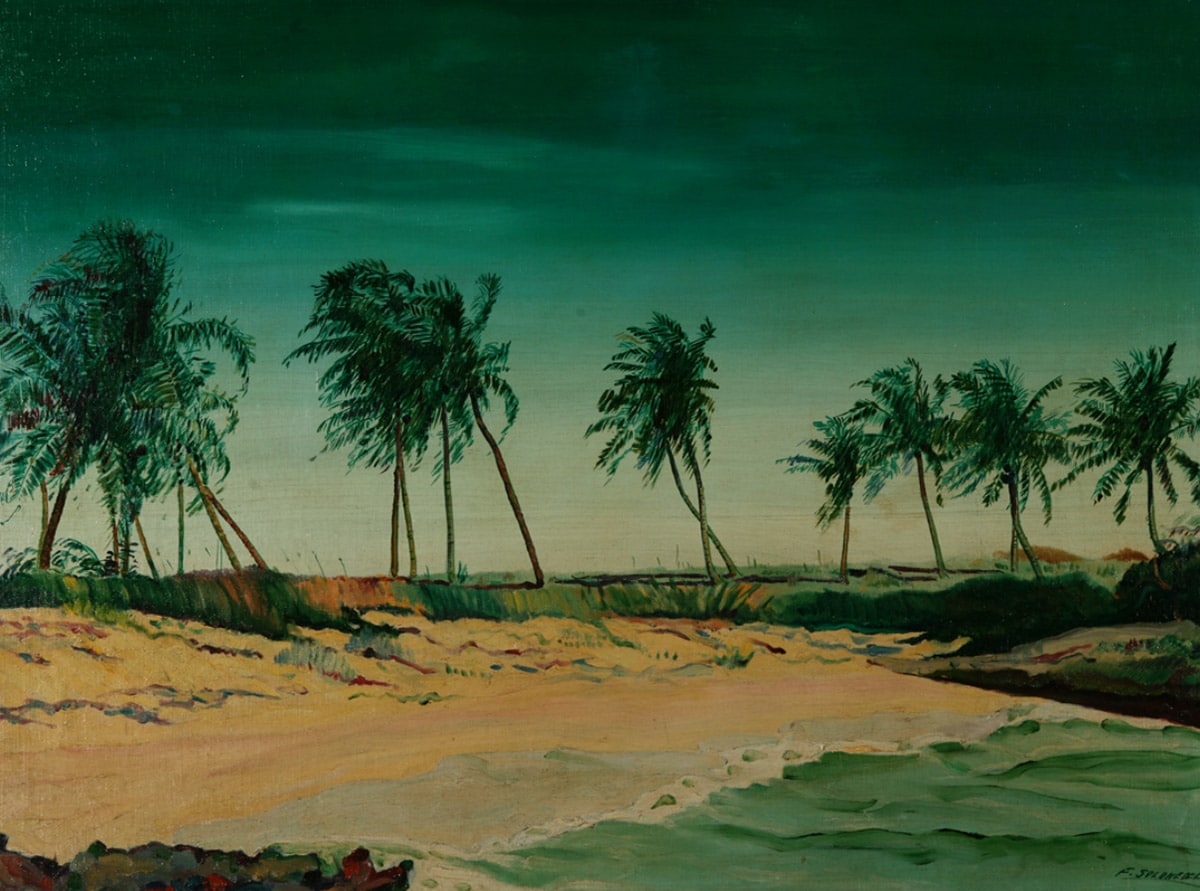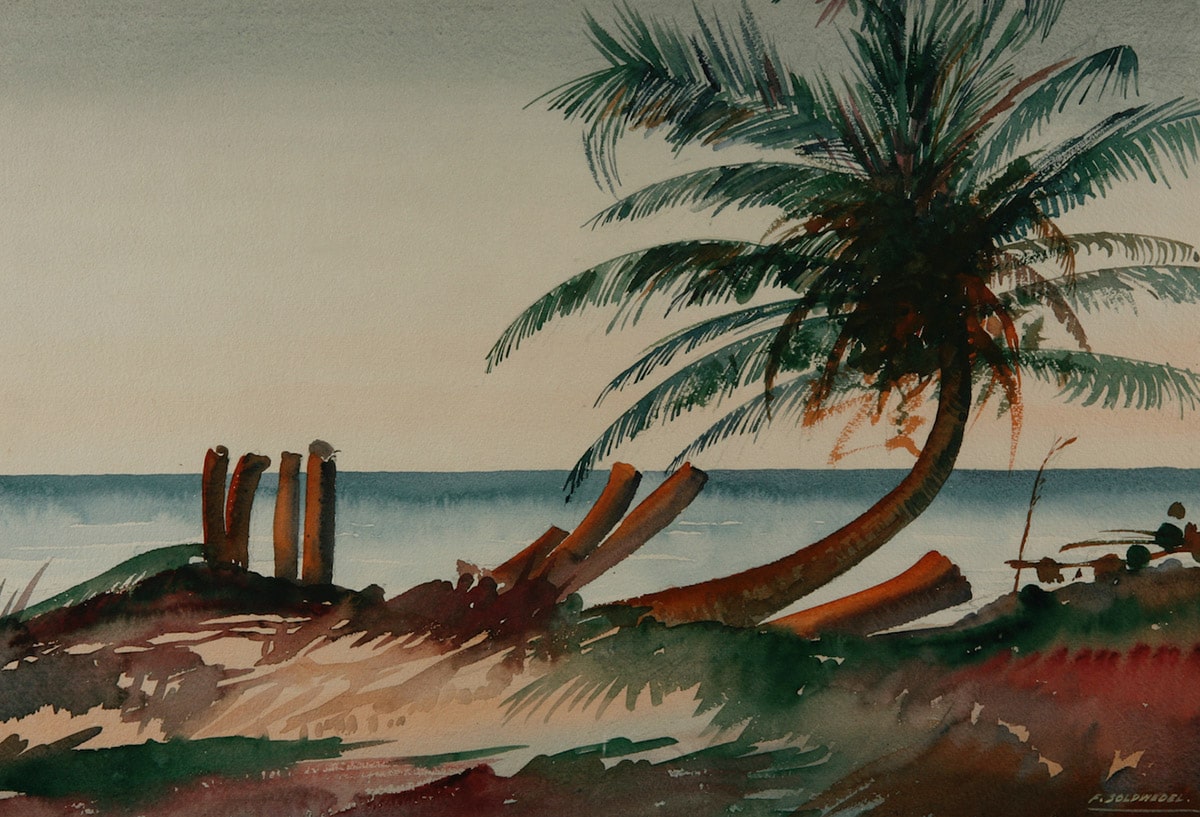
By Dr Ian Bethell-Bennett
The University of The Bahamas
In “Traversing the Picturesque: For Sentimental Value” chief curator, Holly Bynoe brings together a rich tapestry of works from the nineteenth and early twentieth century Bahamas that shift our feelings. These works from diverse artists and styles reflect light and nature in different and nuanced ways. Many of these artists would ‘escape’ the harsh New England, Canadian, European winters, or be inspired by films such as “James Bond 007: Thunderball” to travel to and create with the light of the tropics which had and still has incredible sentimental value.
They saw the light at its best. How light penetrates into the subject, reflects off, refracts through or dances on life. I think refraction or “light passing obliquely through the interface between one medium and another or a medium of varying density” is symbolic and significant in the study of Bahamians, as well as Bahamian influenced and inspired art. This work continues from last week’s exploration of the exhibition.

Treasure Cay, nd. Frederic “King” Soldwedel, watercolour on paper, 16 x 24. Image courtesy of the Dawn Davies Collection.
The life and colour as lived in the islands of the Caribbean would provide uplifting energy and deep reflective studies on island life. At the same time, many artists and poets who experienced the tropics first hand would have seen through western eyes and eventually altered their perspectives as they encountered real-life tropical adventures in bright and textured technicolour, before the advent of the same.
The local eye
As Bahamians, we tend to ignore a great deal about where we live. We see an island, that is not an island, and we see roads and shops and things, or tings, but we miss–because we are here all the time–the way everything comes together. The kaleidoscope of colour and texture that is different here because of the geographic location creates a unique experience for artists and writers. In England people and especially those who grew up in warmer climates, miss the light. Seasons are hugely important because everyone craves warmth and the quality of light heralded by summer months.
The solstice provides a day of celebration as light extends to the wee hours. In Vancouver, the first warm day after a long, cold, dark winter, is met by people stripping off layers and finding a grassy spot on a park to absorb the goodness of what had been absent for months. Light is essential to our mood, to our identity and our health. Such is light’s importance to life as to art.
In The Bahamas, our ‘light’ seasons are distinct from northern or temperate climates. By the time summer arrives the light is beyond what can be useful for art because the colour and its depth shift to a more washed out, overexposed effect on the subject. The sea’s blues become less vivid, less deep and textured. This is especially true in the bright, full-sun of the afternoon. To see the subtle, or perhaps not so subtle shift in light and life, venture along West Bay Street specifically at Go-Slow Bend, where the winter months provide bright blues, cyans and whites as foam dances atop brown rocks and turquoise waters, while seagulls congregate and chatter.


Lone Palm, nd. Frederic “King” Soldwedel, oil on canvas, 24 x 30. Image courtesy of the Dawn Davies Collection.
As April advances into May and May into June, we no longer see this quality of light until the year melts into another and the winter and spring light return. The quality of these months brings the best colours and contrasts to sight. This used to be visible when West Bay Street ran along where Caves Point now stands, and the sea grapes greens and browns, greys and beiges swayed in contrast, as if in harmony, with the blues and greens, turquoises and darker tones of the sea. This is now gone from view, but it is this sort of light and shade that attracts so many to our shores. It is not only the relationship between light and colour but also how those relate to the human soul and resonate with our inner peace and eye.
The Bahamas, as countless visitors, temporary residents and winter sojourners would attest, offers an incredible light and colour field that is found in few places. As the harshness of the northern winter sets in, during which light is limited, and the impact on the human psyche is obvious, artists, in particular, travel in search of a muse or inspiration. Hemingway often found this in Bimini and Havana. Given its uniqueness of geography, Bimini offers deep blue penetration into the fathoms of water, housing incredibly beautiful and splendid marine life. This deep light penetration attracted movie producers who might have vacationed here or wintered here or simply heard about the rich, nuanced beauty of the Bahama Islands from 19th-century accounts of adventures and travels or early 20th-century travel brochures.
At this time, Lyford Cay and Cable Beach boasted holiday homes for many an angler, poet, writer or developer. These, in turn, attracted their friends who would come to capture the beauty of the islands on canvas, paper and wood. Not only was the geography significant in attracting eyes on the tropics, but its combination with clean air and clear waters, unpolluted by paper mills, industrial waste runoff, oil refineries, industrial revolutionary development and progress, that would have sullied other places. This untamed and untainted beauty brought eyes from far and wide a number of whom can be experienced in “Traversing the Picturesque”.
Bynoe presents a wonderful introduction to the exhibition that articulates much of the feeling the works come together to produce. If we read these works as evocations of beauty and island charm and life and light dancing on blue waters, fishermen hauling fish, women selling fruit we can study the deep feeling of the post-Romantic art scene in a world reacting against colonial control and fascism. So much was shifting and changing in the early to mid-twentieth century globally, and a great deal of the serenity depicted in these works bellies the uncertainty and general upheaval of the times.
A great tool for the study of light in the art would be Romantic poetry and art, where the light and the use of colour respond to a more repressive, staid, logical earlier Neoclassic period. The discussion and rendering become more focused on feeling and the emotion art, poetry, light play, and shades can evoke from the artist as well as the viewer.
In art, as in life, nothing occurs in isolation. French Romanticist Charles Baudelaire observes: “Romanticism is precisely situated neither in the choice of subject nor exact truth, but in the way of feeling”. So, for the interpretation or study here the light and colour capture and deflect, reflect and spread feeling. The feeling of work is not only uplifting but so calming and thought-provoking.